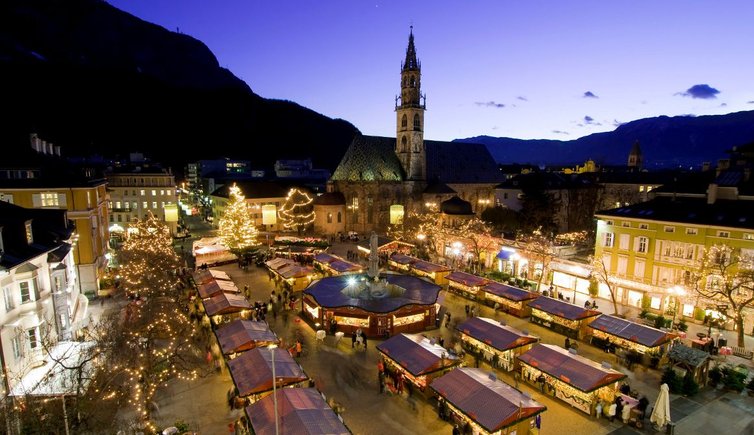 In and around Bozen
In and around Bozen
Favorite meeting places by locals are the café gardens in Piazza Walther and the local statue of Minnesinger (troubadour) Walther von der Vogelweide. On the corner of the square there is a church erected in the fourteenth—fifteenth centuries., destroyed by bombing during World War II and then restored. It was renamed Duomo (House) only in 1964 Year. Currently, it has a conspicuous yellow-green mosaic roof and a delicately carved tower.
A few streets away rises Chiesa dei Domenicani (Dominican monastery). On the walls of the rather neglected cloisters of the monastery in the setting of gothic traceries there are frescoes depicting the life of the fifteenth-century manor. Under the star-studded vault of the Capella di San Giovanni built at the beginning of the fourteenth century, frescoes from Giotto's school have been preserved., including Triumph of Death. The Gothic quarter of Bolzano ends on the other side of the Talvera River (Talfer), where in a year 1928 Mussolini ordered the construction of Piazza Vittoria (Siegesplatz) and erecting a triumphal arch covered with dense inscriptions on it.
There are also two other churches worth visiting in the city. The decoration of the fourteenth-century Franciscan church on Via dei Francescani is a wooden altar carved by Hans Klocher and refined, frescoed cloisters from the same period. The second church stands at the end of Corso Liberta, in the green district of Gries, on the left bank of the Talvery. On the main square of this district, in the shadow of a nearby baroque church rises a Gothic Parroc-chiale, with a beautifully carved and painted fifteenth-century altar by Michael Pacher.
The slopes of the mountains around Bolzano are covered with, to a relatively high level, vineyard terraces, among which two walking routes run from the bottom of the valley. The beginning of Passeggiata del Guncina is at the end of Via Knoller (Knollerstrasse), near Parrocchiale in Gries, while Passeggiata Sant'Osvaldo starts behind the train station on Via Renico (Rentscherstrasse), traverses the hills and connects with the path running over the Talvera River. Another interesting place located near the city is the thirteenth-century Castello Róncolo (Schloss Runkclstein; by bus #1 from the station). The court frescoes preserved in it show hunting, dances and other ways to have a good time, as well as a group of knights on horseback (in summer codz. 10.00-12.00 and 15.00-18.00, in winter 15.00-18.00).
From Monte Renon (Rittner), one of the higher peaks around Bolzano, you can enjoy the view of the whole area. From Via Renon (Rittnerstrasse) there is a cable car to Soprabolzano (Oberbozen), from where through the forest created by the erosion of earthen pillars (half an hour north of COLLALBO) a path leads to other small villages. More energetic tourists can try to climb to the top (2260 m.), from where you can beautifully see the eastern Dolomites. Monte Renon becomes even more interesting in the area around the feast of St.. Bartholomew (24 August), when hundreds of local farmers come here for the annual horse market.
Gastronomy and nightlife
The most common sold on the street (in kiosks on Kornplatz and cafes on Via dei Portici), snacks are wurstel and apfel strudel. On Via dei Portici, Weisse Traube stands out among the restaurants (Uva Bianca), where you can have a company second breakfast for 6000 L, at Via dei Bottai (Bindergasse) there is a restaurant-beer Camllino Bianco specializing in Tyrolean dishes (lVeisses Rossel), and in a wonderful, but dear Griffone (Greif (disambiguation)) in Piazza Walther you can try both Italian dishes, as well as local and in a wide selection (including smoked deer and carpaccio).
In the early evening, street musicians play at Portici, and nearby are Bar Gibó and Spaghetti Express (on the corner of Via Goethe), the most lively premises in the city. Outside of them, nightlife has a fairly limited range, and after 21.00 the streets are already empty. In the center, however,, apart from a few bars there are also a few cinemas. Filmclub Aktuell (Filmclub-Filmrunde), Dr. Streitergasse 20, shows European and American films with Italian or German dubbing, In Casa della Cultura (Kulturhaus), Via Sciliar 1 (Schlemstrasse) theatre groups perform, and sometimes music bands play in a sports stadium (performances announce the ubiquitous posters in the city).
A journey into the countryside
The main bus route from Bolzano leads to Cortina d'Ampezzo (by Val Pusteria), but on the way you have to change several times. Another, a more picturesque route is the Granda Strada delle Dolomiti (Great Dolomites Route). There are no buses, but you can easily hitchhike and cross the Costalungo passes, Pordoi and Falzarego. As you can see from the name, the route runs through the center of the Dolomites, but wanting to really enjoy the enormity of these mountains, it is best to walk along selected trails, away from the crowd of bus tours.
Mountain bikes can be rented at Vello Sport, Via Grappoli 56 (Weintrauben-gasse), In Bolzano for 25 000 L per day, or 35 000 L for the weekend. Bus drivers usually agree to take bicycles to the luggage compartments.
There is also a second approach to the Catinaccio massif from Bolzano, by narrow, rocky gorge of black porphyry called Val d'Ega (Eggental). This route can be traveled by bus from Bolzano, which passes the lake in CAREZZA AL LAGO (KARERSEE), then Passo Costalunga (Karerpass). From the vicinity of this lake you can go deeper into the mountains by cable car or go out on one of the trails from the mentioned pass.
Worth remembering, that provincial bus companies generally serve only localities within the territory of the province, so getting to some places from Bolzano is not so easy, as it might seem at first glance. Example, there are more buses from Trento to Canazei than to other towns in the northern part of the province.